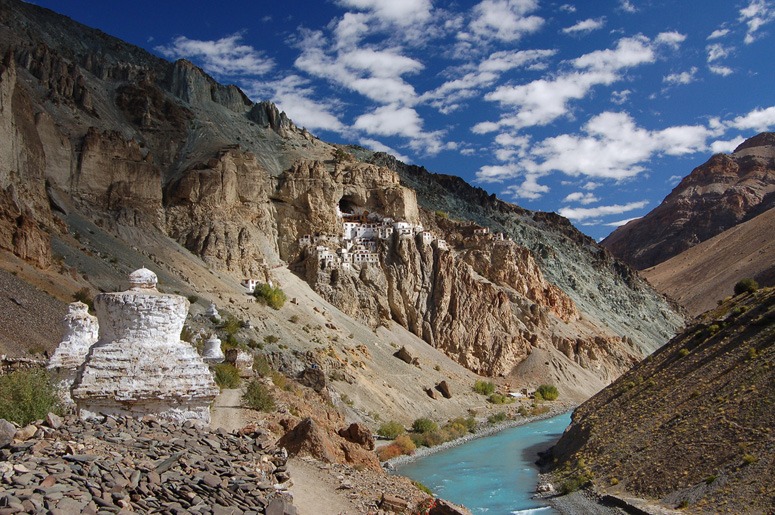The Buddhist cave at Phuktal Gompa (Phugtal Monastery)
The great cave of Phuktal Gompa in Ladakh has a sacred spring within. The monastery is said to have been built here because there was a forest on the slopes above, from which a lone tree survives. The cave is supposed to house the spirit of the first guru, Rimpoche.
Caves have a special place in Buddhism, because wandering monks used them for prayer, meditation and rest, and Ngawang Tsering (1717-94) wrote that: ‘Nurtured as sons of mountain solitude they dressed in clouds and mist and wore as hats deserted caves. Totally unconcerned with the world’s ways and mundane happiness they contemplated impermanence to create a sense of urgency and thus to make the best use of their life time. Meditation on the ominpresence of death served as a pillow and they wrapped themselves up in the cloth of mindfulness of karma. The mats which they spread were their awareness of the disadvantages of samsara which they likened to a whirlpool or a tapering flame. I sing my songs to induce kings to rule with the ten virtues, for the sake of the lowly so that each according to his capacity may rejoice in the Dharma, for the sake of the teachers pointing them to tantras, sutras and teachings, for the sake of earnest meditators that they may realise equanimity and insight, for the sake of the yogins with clear perception that they may be endowed with supreme vision action and function’
Image courtesy Kateharris


The text by Ngawang Tsering sound a little like a Tibetan equivalent of a speech by George Washington? Do you think the values it espouses might found a Tibetan Constitution? Or perhaps it is more like a spiritual constitution rather than a political one?
I think Washington was more concerned with politics and economics and that, as your third question suggests, the Tibetans are more concerned with spirituality. One could, however, contrive an economic explanation of their spiritual concerns. It was always biologically possible, in Tibet, to have many children. But the economy was only able to provide for one male child/family to marry and have children. The other children therefore became monks.
You are right, there are many Tibetan student monks and nuns with no or limited family assistance that need aid to study Buddhism.[ http://www.tibetaid.org/hidden_bios2.html ] Some children are as young as nine.
I wish we could find a way of making monasticism a more-attractive lifestyle choice in the modern world. It would be a good project for the EU, which seems to have an appetite for good projects and a very limited ability to implement them. I like the idea of projects Held Together With Paper Clips and Chewing Gum but it is better if they are not mission-critical projects.
There is some idea that affluence discourages vocations to the spiritual life. But there are always notable exceptions to this concept. They would be great advocates for Western spirituality on a broader stage. [ http://en.wikipedia.org/wiki/Frank_Brennan_(Jesuit) ] and
[ http://en.wikipedia.org/wiki/Timothy_Radcliffe ].
‘Australian Jesuit priest, human rights lawyer and academic’ sounds like a wonderful combination. Let’s hope Frank Brennan becomes an urban designer too! There need to be ways of aligning temporal power with spirituality.
It seems to be a difficult question of how this is best done.
The Pope is no longer a prince and the Dalai Lama has relinquished his temporal position. So the idea that there should be a separation between church and state seems to have the greater currency.
Perhaps the modern model is more like Joan of Arc who spiritually assisted the temporal power? Joan was from a farming family so not at all like Frank Brennan’s background?
It seems that a person’s background is somehow relevant to their spirituality.